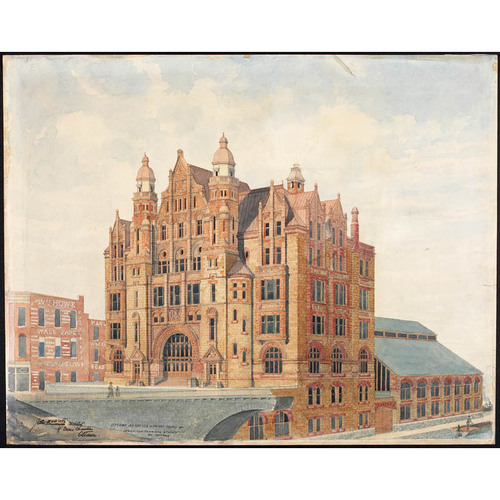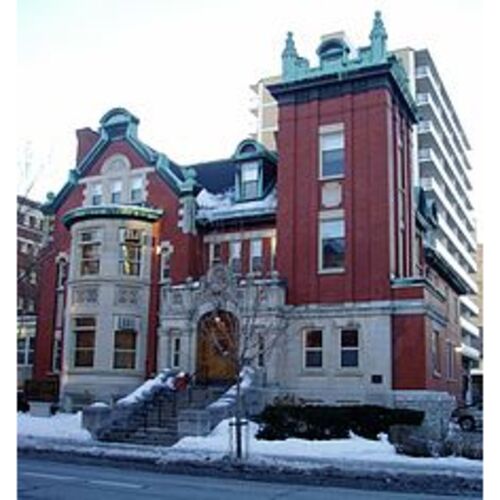
Source: Courtesy of Wikimedia Commons
WATTS, JOHN WILLIAM HURRELL, architect, designer, artist, and civil servant; b. 16 Sept. 1850 in Teignmouth, England, son of John Watts, a ship’s purser, and Susan Hurrell; m. 16 July 1872 Elizabeth Blanche Morris, and they had two daughters and two sons; d. 26 Aug. 1917 in Ottawa.
After an education in a private school John Watts was elected a member of the Architectural Association in London on 22 Nov. 1867. He trained at its school and in an architectural firm until at least early 1871. In May 1870 he was praised in the Builder (London) for a “Design for a London shop front” shown at the association’s class in design. The association’s emphasis on drafting skills and professional values was to be evident throughout Watts’s career.
Watts practised as a draftsman, surveyor, and evaluator in London before immigrating to Canada in 1873. On 19 July of that year he illustrated a post office designed by architect Walter Chesterton for the Canadian Illustrated News (Montreal). Soon afterwards, he was hired as a draftsman by Thomas Seaton Scott*, chief architect for the Department of Public Works, but he continued to produce illustrations for the Canadian Illustrated News, the Dominion Illustrated (Montreal), and George Monro Grant*’s Picturesque Canada . . . (Toronto, 1882–84). Watts’s first project with the department was to prepare drawings for the interior fittings of the Library of Parliament, and he also designed the desks surrounding a statue of Queen Victoria. His specifications book from the 1870s includes an immigrant shed, a drill hall, and a penitentiary, as well as the Kent and Saint-Louis gates in Quebec City, planned as part of a project of Lord Dufferin [Blackwood*] for the city’s fortifications. On the occasion of the arrival in Canada of the Marquess of Lorne [Campbell] in 1878, Watts designed a 50-foot “Civil Service Arch,” an imposing structure with four flag-topped towers on Parliament Hill that was built through subscriptions.
In 1880 Lorne established the Royal Canadian Academy of Arts to present annual exhibitions. Persons elected to the academy were required to donate “a picture which shall become national property and be placed . . . in an art gallery.” Responsibility for the National Gallery was given to the Department of Public Works. Watts, in addition to his post as draftsman, was appointed curator, in charge of the academy diploma submissions and other treasures of the government, though Lucius Richard O’Brien*, president of the academy for its first ten years, provided the lead in aesthetic matters and in building the collection. Space was made available in the Supreme Court building in 1882, and Watts began developing plans for a print room. An executive member of the Art Association of Ottawa, he encouraged students to visit the gallery, and in his report for 1889 wrote, “In order to maintain interest in the Gallery it is of the utmost importance that additions be made each year, and that such additions be of a high class of Art, works worthy of a National Collection.” In 1886 he installed the Canadian art section at the Colonial and Indian Exhibition in London; he may also have visited Lorne, whom he kept informed about the collection after his departure from Canada in 1883.
Watts had himself been elected to the academy in 1880 as an associate member in the designer category. He was promoted to full academician in 1881 when he submitted his diploma work, a pen-and-ink drawing for a stairway. He regularly exhibited designs for furniture, interiors, and buildings, as well as paintings, etchings, and water-colours of landscapes. For the 1881 exhibition he produced designs for parliament buildings in Toronto. He also exhibited with the Art Association of Montreal and the Ontario Society of Artists. His skill with interior decoration was recognized in competitions sponsored in 1880 and 1881 by the American Architect and Building News.
Scott had been succeeded as chief architect by Thomas Fuller* in 1881, and the next year Watts became assistant architect in charge of drawings and the drafting office. In 1892 Fuller claimed that he gave all his instructions to Watts. In 1897 Watts left the public service to start a private practice. He became one of the most successful architects in Ottawa at the turn of the century. He had no partners and relied on his sons for drafting assistance. His most important buildings include the residence for Andrew Walker Fleck built in 1903–5, and that for John Rudolphus Booth*, Fleck’s father-in-law, completed in 1909. Watts’s domestic architecture is distinguished by decorative interior stucco and carved woodwork, as well as by the emphasis placed on front-hall plans with prominent staircases. Among the ecclesiastical commissions he obtained were St Matthews Anglican Church in 1898, St James Presbyterian Church in 1904, and the Adath Eshuroon Synagogue in 1904, all in Ottawa, and St Augustine’s Anglican Church in 1902 in Galetta. For the altar of St Margaret’s Anglican Church in Ottawa, where he was people’s warden, Watts painted a scene of Christ seated between St Margaret and St Lucy, as well as emblems of the Apostles for the ceiling of the sanctuary.
John Watts had been among the founders of the Ontario Association of Architects in 1889, and in 1906 he was named the first president of its Ottawa chapter. In 1907 he was elected treasurer of the newly founded Architectural Institute of Canada (granted the prefix Royal in 1909). He last exhibited with the Royal Canadian Academy in 1913, and died in 1917.
AO, RG 22-354, no.8358-271. Montreal Museum of Fine Arts, Reference Library, Watts
Cite This Article
John B. Collins, “WATTS, JOHN WILLIAM HURRELL,” in Dictionary of Canadian Biography, vol. 14, University of Toronto/Université Laval, 2003–, accessed December 25, 2025, https://www.biographi.ca/en/bio/watts_john_william_hurrell_14E.html.
The citation above shows the format for footnotes and endnotes according to the Chicago manual of style (16th edition). Information to be used in other citation formats:
| Permalink: | https://www.biographi.ca/en/bio/watts_john_william_hurrell_14E.html |
| Author of Article: | John B. Collins |
| Title of Article: | WATTS, JOHN WILLIAM HURRELL |
| Publication Name: | Dictionary of Canadian Biography, vol. 14 |
| Publisher: | University of Toronto/Université Laval |
| Year of publication: | 1998 |
| Year of revision: | 1998 |
| Access Date: | December 25, 2025 |





